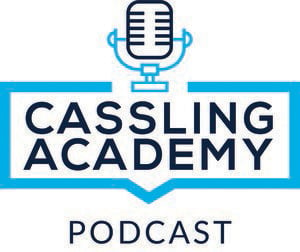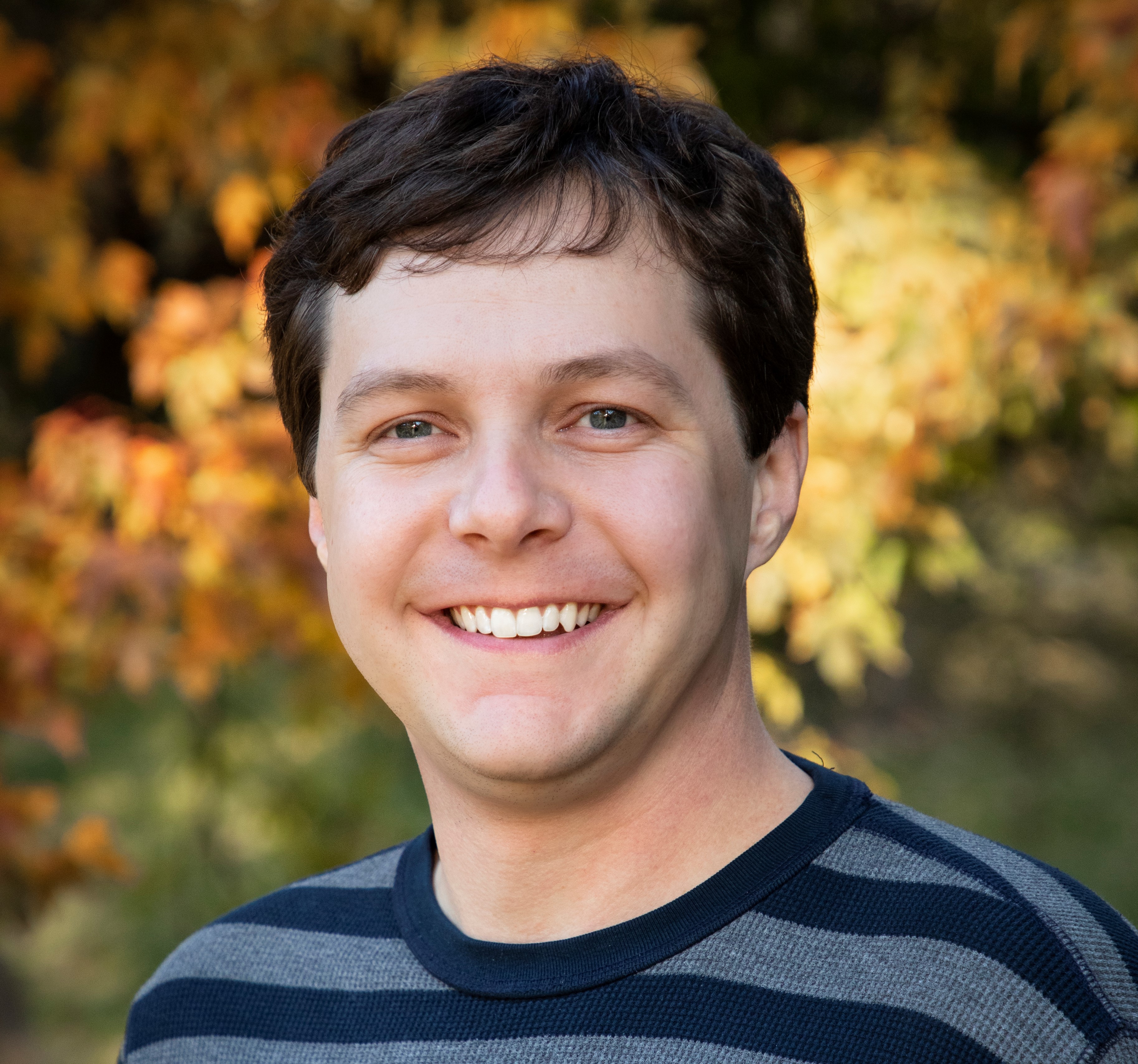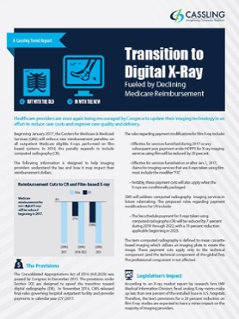Rad Tech Education Deep Dive on the Podcast
by Marc Costanzo on Nov 21, 2019

In the newest episode of the Cassling Academy Podcast, Cassling Marketing Strategist Marc Costanzo (filling in for Kyle Salem) talks to Kate Rollins, MHA, R.T. (R)(M), Program Director of the Radiologic Technology and Imaging Sciences Program at Nebraska Methodist College, a nursing and allied health institution based in Omaha, Nebraska.
During their in-depth conversation, Kate shares the current state of radiography and imaging education, explains what’s changed in education and the radiology field over the years, and gives a preview of what aspiring rad tech students can expect in the future in both their clinical education and their careers as a whole.
The following is an interview transcript edited for clarity and length. If you prefer, you can listen to the full podcast in the player below.
From Clinical Expert to Educator
Marc Costanzo: Hello and welcome to the Cassling Academy Podcast. I'm Marc Costanzo here interviewing Kate Rollins, the program director of radiography at Nebraska Methodist College. Kate, thank you for being on the podcast.
Kate Rollins: You're welcome. Thank you for inviting me.
Marc Costanzo: No problem. We're going to talk about the current state of rad tech education, what's been happening, what's going to happen. But I'd like to just start off with you telling me a little bit about your background.
Kate Rollins: I am a 30-plus year radiographer, so I've been in the profession quite a while. I've gone through many different changes. I did some different modalities of course, as did everyone. I did surgery as well as diagnostic radiography. And then I specialized in mammography for quite a few years.
At that time, I got mentored by another educator at the hospital. I decided I might have a flair for education, so I started teaching a course or two at a time and then it turned into a full-time gig.
Marc Costanzo: So how did you make that transition? Where did your “flair” come from? Did you ever expect to be a teacher?
 Kate Rollins: I did not expect it. I think it was probably the fact that I got along well with students, mentored them a little on the easier side or the better side with my humor. I was not as critical as sometimes we can be. I understand that education is important to every level of a radiographer's life, so I try to always emphasize that we can all still learn no matter what our level is. I think that made me an easy fit for a radiography program.
Kate Rollins: I did not expect it. I think it was probably the fact that I got along well with students, mentored them a little on the easier side or the better side with my humor. I was not as critical as sometimes we can be. I understand that education is important to every level of a radiographer's life, so I try to always emphasize that we can all still learn no matter what our level is. I think that made me an easy fit for a radiography program.
Marc Costanzo: And how long have you been teaching?
Kate Rollins: I have been teaching for 22-plus years. I advise as well as instruct our students several classes per year. We have two cohorts going all the time. We have first-year students and second-year students, and we also have a bachelor's program that I teach primarily online.
The State of Radiography Education
Marc Costanzo: Tell me a little bit about the online courses. How has that transition been and are you finding that students respond well to that? Because so much of being a rad tech is hands-on, how does that translate to an online course? What's been your experience with that?
Kate Rollins: Online courses work well as far as the education or the base components, but I haven't seen the clinical side work well with online education yet. I'm sure somebody out there is doing it, I just have not experienced it myself.
Marc Costanzo: Is the field moving primarily towards the bachelor degree being the standard?
Kate Rollins: My personal feeling is, as nurses go, radiography goes. So as we see nursing switch to a four year entry-level BSN (Bachelor of Science in Nursing), I think radiography will follow. I tell my students that, in their current lifetime, entry-level will probably become the bachelor's level.
Marc Costanzo: Do you have a favorite subject that you teach?
Kate Rollins: Probably my favorite subject is imaging. I think there's so many nuances to imaging. To make students understand the differences between density and contrast and how that transitions to the digital world takes a lot of education and a lot of examples, plus a lot of classroom feedback and working together to understand those nuances.
Marc Costanzo: What is your favorite part about being an educator?
Kate Rollins: I like the diversity of students. We get all levels of students, from those right out of high school all the way to people entering their second or maybe their third career. And I think that's very challenging as an educator. It's also kind of nice for the learning process when students get to experience the different levels of learning and all those different subject groups.
Marc Costanzo: Given that a student may come from so many diverse backgrounds, what is it that unites them in being an ideal student?
Kate Rollins: We try to do a little level-setting before they even apply and emphasize that they really need to know what they're getting into. I think a lot of people really don't understand. For me, radiography is the perfect melding between patient care and those who are maybe a little more computer-savvy. You get to work with computers every day and you get to work with a lot of digital equipment and high-powered equipment and high-dollar equipment. I think that's a perfect melding of two worlds. If you like technology and you like patient care, this is a good fit for you.
Marc Costanzo: I would imagine too that you probably need a willingness to adapt as technology evolves. You have to keep getting CEs so you can always be learning what the new hot trend is that's going to become the standard in a few years. Is that true?
Kate Rollins: Absolutely. I think as soon as a piece of equipment hits the floor in the Midwest, especially here in the Omaha area, there's already changing equipment and protocols on the East and West Coast that students need to be aware of. So yes, that is very important component of it.
Marc Costanzo: What would you say surprises students the most as they either start their curriculum or maybe as they get into clinical responsibilities?
Kate Rollins: I hear most often that students love the clinical component but the classroom portion is their biggest challenge. Typically, if you think about it, a student who applies to a radiography program or any medical field already knows they're going to take care of patients. So they have to be that kind of personality who wants to take care of others and looks to others’ needs. I think the classroom is probably their biggest surprise, because they start to see how in-depth the radiography program is.
Marc Costanzo: Would you say some students struggle with that component?
Kate Rollins: They do, but we have a lot of checks and balances in place where we always keep students up to date. We offer a lot of services such as tutoring. We also use digital snippets for students to read up on if they're having trouble in one component of the digital classroom. There's always YouTube videos too; that three to five-minute window seems to be very good for student learning.
Marc Costanzo: Tell me a little bit about the learning environment here at Nebraska Methodist College. I'll give you the chance to sort of plug your institution a little bit.
 Kate Rollins: We have a lot of state-of-the-art equipment here in our facility. We have very large screen TVs that students can hook their appliances to or project one image on one screen to use in a group setting. Even the furniture here at Nebraska Methodist College can be individualized for each student or work in groups of four or larger pods.
Kate Rollins: We have a lot of state-of-the-art equipment here in our facility. We have very large screen TVs that students can hook their appliances to or project one image on one screen to use in a group setting. Even the furniture here at Nebraska Methodist College can be individualized for each student or work in groups of four or larger pods.
We have a lot of active learning education here at Nebraska Methodist and the students seem to respond very favorably to that. Active learning is all about getting the student more involved. It’s less about PowerPoints in my lectures and more about activities that demonstrate the objectives we're trying to show that day or for that particular lesson.
Rad Opportunities
Marc Costanzo: What would you tell students about your program if they're wanting to get into healthcare but don't realize the specializations that are out there because maybe all they hear about is nursing or the careers that stick in their mind from watching medical shows? What would you want them to know about your program and about the field in general?
Kate Rollins: I think radiography is great because no day ever looks the same, even within 10 minutes. Whereas nursing they might spend a whole week with a patient in a certain room and that's their assigned patient for the week, we don't really get that. Our day changes from moment to moment, exam to exam. We get all different kinds of levels of patient care.
We get the walk-ins that come in from the outpatient setting. We get inpatient care, patients that are already in the hospital, and then we get quite a few patients from the trauma centers. I think it's more exciting that way. Your day never looks the same, and you get to do many different aspects of the job during that day.
Marc Costanzo: That's something I imagine students may not realize; even within radiography, there's all these other types of specializations. Like you said, trauma or working in a clinic versus working at a hospital could be very different workflows.
Kate Rollins: That's the thing about when you're a radiographer, you can advance your career no matter what stage you are at. Obviously, we need entry-level radiographers who do the diagnostic work, but we also need trauma and surgical radiographers. We need nuclear medicine, CT, MRI, PET scan, we need mammography. All the different radiation therapies, all the different modalities that can you can advance through in radiography as a career.
Marc Costanzo: Awesome. I've looked at the statistics a little bit, but in your opinion, what is the job outlook right now for students who are graduating or maybe graduated a while ago and might be looking to make a switch?
Kate Rollins: I'm going to speak just for the Omaha Metro area because I do read professional blogs and other journals that say the outlook for jobs is maybe not so good in the South or the East coast, but here in the Midwest it's wonderful, especially here in Omaha. Our last class is 100% employed and they just graduated the first week of August. So we're very happy about that.
I think that, for the majority of the positions, everybody's a little bit more confident in our economy now and third-party pay has increased in certain areas, so I think they're creating a few more jobs. Some older radiographers maybe feel free to retire and be financially stable. I think both of those aspects together create a lot of new jobs and openings here in the area.
Evolving Modalities
Marc Costanzo: What would you say has changed the most since you started?
Kate Rollins: Oh, I would say technology is huge, right? The equipment has changed and continues to evolve. Everything now has such a smaller footprint and it takes less and less human involvement to create an X-ray image now. But it still takes the right amount of education to understand the process in order to manipulate our images. I would have to say that the technology changes the fastest.
Marc Costanzo: How do you keep up, then, as an educator, knowing that we might be getting new equipment in? Because you have to learn that like the back of your hand.
Kate Rollins: I really rely on our vendors to keep me up on education. They supply me a lot of pamphlets about new equipment and, of course, I also have to keep up my continuing education. A lot of knowledge is supplied through that. I also read a lot of professional journals. I belong to quite a few professional societies, so I really get to take advantage of all the information that's out there.
Marc Costanzo: Do you see any particular modality experiencing more change? My mind goes to mammography right now, which is sort of in this 2D to 3D switch where it's evolving, and breast density is definitely a huge conversation.
Kate Rollins: I would have to say mammography. The emotions tied to women's services happen to run higher. There's a lot of funding that's funneled into women's services to keep up on the latest technology for mammography and breakthroughs for breast cancers. So that treatment as well as the equipment is always changing, which is good. It's bettering the odds for our patients especially.
There are a lot more breast cancer survivors now than there have been ever in our history. So that's good. I would have to say the biggest change that I see on a daily basis is the number of diagnostic procedures now going to the CT modality. Even the workload of our staff has changed. We’ve reduced the number of diagnostic radiographers and now we're increasing the number of CT-registered radiographers to meet that demand.
Marc Costanzo: Why do you think that is? Why are they moving toward CT?
Kate Rollins: I think it's just an easier exam for the patient, which would otherwise be more time-consuming. The diagnostic can now be done in a five-minute CT versus a 30-minute procedure in radiography. So I think that's a lot of it. And as third-party payers start to pay for higher, advanced-level imaging, that's where the images go.
What the Future Holds
Marc Costanzo: That definitely makes sense. In closing, what do you see as the future for radiologic technology?
Kate Rollins: Boy, if I had my magic eight-ball and I could shake it and tell you what the future would be, I think all radiographers should be bachelor level at some point here in the future. In probably 10 years, entry-level will be the bachelor level.
I do continue to see diagnostic procedures going to different modalities as far as initiating the diagnosis. I think surgery will increase even if it's laparoscopically or less invasive types of surgeries. That will increase. I also see some new technologies that will be coming up that will be exciting. There will be some new radionuclides introduced and there will be different types of imaging that will be faster and better for imaging and high-detail sensitivity.
Marc Costanzo: Anything else you'd like to add before we close?
Kate Rollins: I just encourage people who are in the profession to continue keeping up with your continuing education. Learn as much as you can. If you think it's too late to go back to school, it’s not. There is always a program available out there for you to maybe make your career. If you've ever wanted to do something different with your career, there's certainly more advantages now than ever before.
Marc Costanzo: Awesome. I think that's a great place to end. Kate, thank you very much for talking with me today. This was super informative, so I really appreciate it.
Kate Rollins: Thank you very much.
Marc Costanzo: You're welcome. And if anybody wants more information on Nebraska Methodist College or the program here, you can visit methodistcollege.edu and again, thank you very much. Have a good day.
Kate Rollins: You too.
Meet the Author
Marc Costanzo is the Marketing Content Strategist for Cassling and its parent company, CQuence Health Group. He has copywriting, marketing and advertising experience across a wide number of industries, including healthcare, education, law and entertainment. He previously served as Senior Copywriter for an Omaha- based ad agency, Marketing Strategist for Nebraska Methodist College and as an adjunct instructor at Metropolitan Community College. In his current role, Marc is responsible for developing and executing marketing campaigns for Cassling, as well as hospitals and clinics across the United States. He studied journalism and broadcasting at the University of Nebraska-Lincoln. Marc is a nerd for anything related to SEO, lead generation, patient outreach, tacos and monster movies. In addition to his work in the healthcare marketing field, he is a published author whose most recent thriller, ‘Persistence,’ was named one of the top picks of the summer by Audible.





Comments